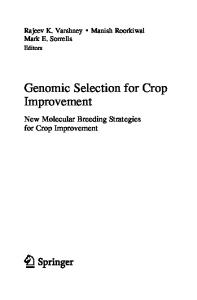Genomic Selection for Wheat Improvement
Recent advances in plant breeding and agronomic practices have contributed significantly to the annual genetic gain in crop productivity to the tune of 0.8–1.2%. However, the present rate of gain is insufficient to meet out the fast-growing food demand of
- PDF / 7,179,792 Bytes
- 296 Pages / 439.43 x 683.15 pts Page_size
- 17 Downloads / 340 Views
iological, Molecular, and Genetic Perspectives of Wheat Improvement
Physiological, Molecular, and Genetic Perspectives of Wheat Improvement
Shabir H. Wani • Amita Mohan Gyanendra Pratap Singh Editors
Physiological, Molecular, and Genetic Perspectives of Wheat Improvement
Editors Shabir H. Wani Mountain Research Centre For Field Crops Sher e Kashmir University of Agricultural Sciences and Technology Khudwani, Jammu and Kashmir, India
Amita Mohan Department of Biology University of Pennsylvania Philadelphia, PA, USA
Gyanendra Pratap Singh ICAR-Indian Institute of Wheat & Barley Research Karnal, Haryana, India
ISBN 978-3-030-59576-0 ISBN 978-3-030-59577-7 (eBook) https://doi.org/10.1007/978-3-030-59577-7 © The Editor(s) (if applicable) and The Author(s), under exclusive license to Springer Nature Switzerland AG 2021 This work is subject to copyright. All rights are solely and exclusively licensed by the Publisher, whether the whole or part of the material is concerned, specifically the rights of translation, reprinting, reuse of illustrations, recitation, broadcasting, reproduction on microfilms or in any other physical way, and transmission or information storage and retrieval, electronic adaptation, computer software, or by similar or dissimilar methodology now known or hereafter developed. The use of general descriptive names, registered names, trademarks, service marks, etc. in this publication does not imply, even in the absence of a specific statement, that such names are exempt from the relevant protective laws and regulations and therefore free for general use. The publisher, the authors, and the editors are safe to assume that the advice and information in this book are believed to be true and accurate at the date of publication. Neither the publisher nor the authors or the editors give a warranty, expressed or implied, with respect to the material contained herein or for any errors or omissions that may have been made. The publisher remains neutral with regard to jurisdictional claims in published maps and institutional affiliations. This Springer imprint is published by the registered company Springer Nature Switzerland AG The registered company address is: Gewerbestrasse 11, 6330 Cham, Switzerland
This book is dedicated to Dr. Sanjaya Rajaram
Dr. Sanjaya Rajaram, a globally decorated scientific laureate covered in various communications outlets like Wikipedia, news, and magazines. This dedication is additive to those for an exuding format and diction similarities as composed here. Sanjaya Rajaram was born in 1943 in a small farming village Raipur, District Varanasi, in the state of Uttar Pradesh in northern India. His family, including his parents, an older brother, and a younger sister, made a living on their five-hectare farm growing wheat, rice, and maize. Unlike most children in his socioeconomic position, he was encouraged to pursue an education by his parents and graduated from secondary school as the top-ranked student in the Varanasi District. Rajaram went on to earn a BSc in agricu
Data Loading...











